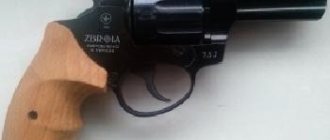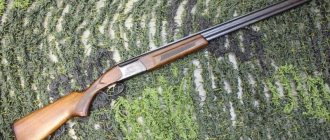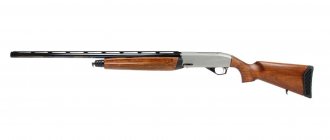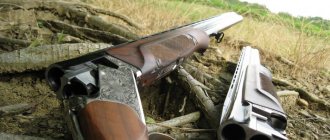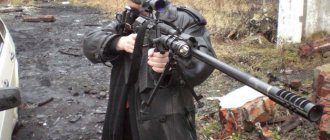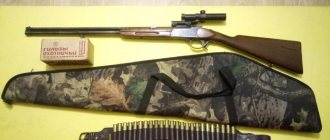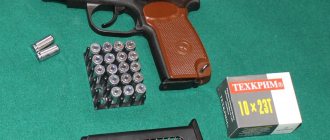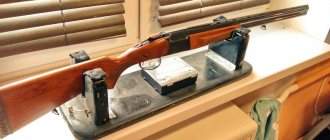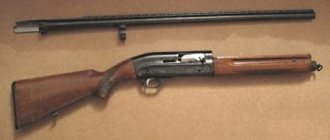It is not for nothing that the MP-27M is called the most “popular” double-barreled rifle with a vertical barrel arrangement. It is simple, unpretentious, incredibly reliable and affordable.
Double-barreled over-and-under shotguns appeared sometime in the mid-20th century. Such a rifle not only looks more aesthetically pleasing, but is also more compact. It is believed that the vertical layout expands the hunter's field of vision. While the horizontal position limits the view.
MP-27 M is a famous double-barreled shotgun produced by the Izhevsk Mechanical Plant (manufacturer of such famous models as MP-161K, MP-142K, MP-143, MP-94 Express, MP-43KN, MP-133, MP-233, MP -18MN, “North”, MR-155 K).
Review of the MP-27 M shotgun
MR-27 M has been produced by IZHMEKH for more than 40 years. Despite such a long existence, the double-barreled shotgun still enjoys steady popularity among professional hunters and among amateurs.
In addition, modification of the design made it possible to launch models with combined rifled and smooth barrels.
Advantages and disadvantages
The MP-27 M shotgun is used mainly for hunting, but can also serve as a means of self-defense. The line is produced for different calibers and in different modifications, so among the range of vertical double-barreled shotguns you can find an option for almost any type of hunting.
The model is popular not only in Russia, but also abroad. For import, a version chambered for magnum cartridges with a longer chamber is available.
The undoubted advantages of a double-barreled shotgun include the following qualities.
- High accuracy - from a standard distance of 35 m, the shot is placed in a circle measuring 750 mm. And according to hunters, the rifle responds well to all activities designed to increase the accuracy of the battle.
- Safety - the MP-27 M is equipped with both an automatic fuse and trigger interceptors - inceptors. This solution completely eliminates the possibility of an accidental shot.
- The barrels are made of the strongest weapon steel, the channels and chambers are chrome-plated, which improves both accuracy and corrosion resistance of the product. The barrels are connected to each other by soldering and pressed into a coupling. The rifle's toss is reduced by compensation holes in the muzzle.
- Several modifications of the line are produced - with an ejector, for sports shooting, with two triggers, and so on. In addition, the Izhevsk plant offers models for shooting lead and steel shot - the products are marked accordingly.
- The design of the rifle is simple but reliable - the failure of a rifle is something exceptional. The point is in the combat spiral springs, which ensure trouble-free operation of the mechanism.
The product also has disadvantages.
- Despite the rigidity of the design and reliability, the rifle has a weak link - soldering on the barrels. The side bar comes off quite often.
- The MP-27M is quite heavy - this property can be both a disadvantage and an advantage. When hunting and shooting with small calibers, the weight of a double-barreled shotgun becomes a “significant” disadvantage. However, it also reduces recoil and allows the use of more powerful ammunition.
Purpose
The MP-27 M is available in calibers from the most popular 12 to .410. respectively. Used for a variety of types of hunting.
- Most often we are talking about hunting medium and small animals from a distance of 40–60 m. For these purposes, a vertical double-barreled shotgun is the best option.
- Bird hunting is preferable with the cylindrical barrel version.
- For long-distance hunting - the same fox in the field, a bird during migration - a combination gun with a rifled and smooth barrel is suitable.
MP-27 M – hunting rifle. It is not very convenient to use it for sports shooting, except for a special model. However, the gun, of course, is also used for recreational shooting or spending time at the shooting range.
Varieties
The MP-27M is produced for the following calibers: 12/76, 16/70, 20/76, 28/70, .410/76. In addition, models can have different chamber lengths - for conventional ammunition, and for. "magnum". Standard choke constrictions are arranged as follows: the upper type is F, and the lower is M.
The following modifications are distinguished.
- MP-27M - basic version with two triggers.
- MP-27E M - the rifle is equipped with an ejector that ejects only the spent cartridge case. The unfired one moves forward only slightly. The ejector can be turned off even in the field if necessary.
- MP-27M-1S is a model with one trigger. The order of the shot is set at will by pressing the trigger forward.
- MP-27E M-1S – equipped with one trigger and an ejector that ejects the spent cartridge case. The sequence of shots is adjustable.
- MP-27 EM-1C “Sporting” – features a more ergonomic buttstock with a rubber butt pad to reduce recoil. The rifle is equipped with a wide sighting bar, one of the two front sights is colored, which ensures better visibility. The handguard is wide, sporty type. There are holes in the muzzle of the barrel to reduce muzzle pressure.
Some double-barreled shotguns of 12 gauge and with a chamber length of 76 mm can be equipped with a replaceable block of 20-gauge barrels with a Lancaster drill - oval-screw. 2 wide grooves appear in the barrel, but the gun itself is still classified as a smoothbore.
In addition, individual models are produced, for example, MR-27M-M TK "Rus". The rifle is decorated with silver engraving, the locking mechanism is with a carbide insert, and the barrel is exceptionally blued. The kit includes 2 pairs of barrels: a half-choke with a length of 725 mm and a cylinder-cylinder with a length of 610 mm. True, the cost of a piece product is almost 3 times higher than a serial one.
The technical characteristics of the MP-27M shotgun are described below.
Modifications
Shotguns with incomplete disassembly
Among the numerous serial, piece, export and other modifications there are:
IZH-27 16 and 12 gauge - the main model; IZH-27-1S is a hunting rifle without an ejector with one trigger and a sequential order of shots; IZH-27E - a gun with an ejector from G. Ya. Protopopov; IZH-27E-1S - a sports and hunting model with a switchable ejector and one trigger; IZH-27ST and IZH-27 SK are sports guns for trench and round shooting, respectively, with barrel lengths of 760 and 660 mm; IZH 27M (MR-27M) - a gun without an ejector with two triggers, there were variations of the IZH-27M “Junior” for women and teenagers with a reduced butt length and the IZH-27MM chambered for the 12x76 mm Magnum cartridge; IZH-27EM (MR-27EM) - a model with a switchable ejector that ejects only the spent cartridge case, has two triggers; IZH-27M-1S (MR-27M-1S) - an ejectorless model with one trigger for combat and a second for setting the sequence of shots; IZH-27EM-1S (MR-27EM-1S) is a modification of the previous model with a switchable selective ejector.
The technical characteristics of the IZH-27M have minor differences from the original. In 2005-09, export models of IZH-27 were produced by order of Remington Arms. They were sold in the USA as the Remington Spartan 310.
Specifications
The caliber, chamber length, and maximum possible powder pressure are indicated on the breech coupling. If the use of steel shot is allowed, the stamp “Steel shot” appears on the barrel. The data in the table is given for serial models intended for lead shot.
| Options | Parameter value | |||||||
| Caliber | 12 | 16 | 20 | 28 | 32 | 12 | 20 | .410 |
| Length, mm | Chamber | 70 | 76 | |||||
| trunk | 660, 750 | 710 | 660, 750 | |||||
| Bore diameter, mm | 18,4 | 16,8 | 15,7 | 14,0 | 12,5 | 18,4 | 15,7 | 10,3 |
| Average maximum gas pressure, MPa | 65/74 | 68/78 | 72/83 | 90/105 | ||||
| DR | +0,4 | – | – | – | – | +0,4 | – | – |
| C | 0,0 | 0,0 | 0,0 | 0,0 | 0,0 | 0,0 | 0,0 | 0,0 |
| IC | 0,25 | 0,25 | 0,25 | 0,15 | 0,15 | 0,25 | 0,25 | 0,12 |
| M | 0,5 | 0,5 | 0,5 | 0,25 | 0,25 | 0,5 | 0,5 | 0,25 |
| I.M. | 0,75 | 0,75 | 0,75 | 0,40 | 0,38 | 0,75 | 0,75 | 0,38 |
| F | 1,0 | 1,0 | 1,0 | 0,6 | 0,5 | 1,0 | 1,0 | 0,5 |
| T | 1,25 | – | – | – | – | 1,25 | – | – |
| XF | – | – | – | 0,8 | 0,7 | – | – | 0,7 |
| Gun weight, kg | 3,4 | 3,65 | 3,1 | 3,6 | 3,3 | 3,2 |
The weight of a rifle with a block of barrels with Lancaster drilling reaches no more than 3.8 kg.
Other inscriptions and signs.
Since information about technological markings is extremely scarce and not so interesting, it remains to talk about signs that are mandatory only in some cases and about optional signs and inscriptions.
Typically this group includes the names of trading companies, the Quality Mark, the inscriptions “Made in Russia”, monograms of the owners and dedicatory inscriptions. Some of the additional markings are mandatory only for shotguns on the domestic market. The other part of the additional marking is mandatory only for export, but since the industry standard allows its presence for guns on the domestic market, this marking is placed on all guns - because it’s easier to make the tool and there’s no need to keep extra records. Of course, after entering the foreign market, Izhmekhzavod also tried to introduce international markings on all its weapons. At the same time, they practically stopped producing 16-gauge shotguns. In this regard, Tula have always focused on deep Russia and Siberia, producing, for example, TOZ-34 28 caliber in relatively large quantities.
4.1. The Quality Mark according to GOST 1.9-67 was assigned to different models of guns in different years, for example, on the IZH-26E, it began to be applied since 1970 only to guns intended for the domestic market of the country. This mark is not present on export-made guns sold in the Union. Canceled at the end of 1990.
4.2. The inscription “Made in the USSR” was applied only to the boxes of export-made shotguns, usually in Russian or, at the customer’s request, in English. In March 1992, the inscription was logically transformed into “Made in Russia.” May not be available on shotguns for the domestic market.
4.3. It is probably worth mentioning that manufacturers of double-barreled shotguns from the PMC countries mark their weight on the barrels, but this marking is not mentioned at all in the list of mandatory ones. The meaning of its application is completely unclear; it is not found on Russian-made guns.
4.4. Owner's signs. According to special instructions, inscriptions with the names of importing companies were applied to the barrels of individual batches of guns. For example, on one of the batches of IZH-81 shotguns, on the right side of the barrel, at the request of the customer, the following was written in laser:
IMPORTED BY CAI ST.ALB.VT
please read owners manual before firing
The last line translates to “before use, please read the instruction manual.” Such an inscription is now common not only for American hunting rifles.
Sometimes, for private orders at the factory (and not only), fancy monograms of the owner were applied to the cylinder or trigger guard of the gun. A monogram or dedicatory inscription can also be placed on a special plate embedded in the butt.
That's all that can be said briefly about the inscriptions on Izhevsk guns.
V. Valnev, weapons engineer
Read cyber fiction online on Phantom Worlds
Design
The MP-27M consists of a receiver with a butt and a receiver unit with a forend.
- The barrels are joined in a vertical plane and connected by a breech coupling and interbarrel strips - two side and top. The upper one is of the ventilated type. The barrels are locked thanks to a sliding locking bar: it is inserted into the hole of the hook on the coupling. When the barrel is opened, the bar and the release lever are held in place by a delay. When closing the gun, the delay automatically releases the rib.
- In a barrel block with a Lancaster drill, the connection is made through the breech and muzzle couplings. The lower barrel is fixed in the muzzle coupling, always with a gap to prevent thermal deformation. The alignment of the trunks according to STP is achieved by adjusting a special nut with a screw. Turning it by one click means changing the distance between the STP of the barrels by 7 mm at a distance of 100 m. When the nut is rotated clockwise, the STP of the upper barrel moves up relative to the lower one, and counterclockwise - downwards relative to the STP of the lower barrel.
- In addition, the Lancaster drilled barrel is equipped with adjustable sights: the front sight on the muzzle coupling can change its position vertically, and the rear sight can change its position horizontally. The barrel is complemented by a dovetail sighting rib, which allows you to install an optical sight on the rifle.
- In models without an ejector, the sleeve is pushed out by the ejector and removed manually. In double-barreled shotguns with an ejector, the device ejects the spent cartridge case when the barrel is opened. The ejector can be turned off by moving the disconnector 90 degrees.
- The trigger is mounted partly on its base, partly in the receiver, and is equipped with internal hooks. The firing pins are made separately from the triggers, are spring-loaded and fixed in the sockets of the box. Twisted cylindrical springs are used as combat springs, ensuring the reliability of the mechanism. Trigger interceptors are installed to prevent an accidental shot when the trigger breaks or the gun falls, for example.
- The automatic safety is activated when the lever is turned: it locks the sear when the triggers are cocked. When the safety is moved to the "safety" position, the sears are not locked. When the barrel is opened, the safety lock automatically locks the sear.
- On single-trigger shotguns, the standard sequence is that the lower barrel fires first, then the upper. The sequence can be changed: to do this, move the trigger forward until it clicks.
- The stock and fore-end are made of walnut or beech. On sports models, a rubber butt pad is provided.
Operating principle
MP-27M is a line of double-barreled vertical shotguns with some changes in design, but with a single principle of operation. Guns are designed to fire cartridges with plastic, metal and paper cartridges, as well as bullets with a diameter 0.2–0.3 mm less than the diameter of the barrel bore. At the same time, it is prohibited to use caliber bullets made of hard materials - steel, brass.
All models require the use of lead shot. For steel shot, special modifications are produced, the barrels of which are marked “Steel shot”. The same applies to choke constrictions: those that can be used for shooting steel shot have about.
A rifle with a chamber length of 70 mm allows the use of cartridges of any kind, with the exception of those marked “Max.1050 bar”. A shotgun with a chamber length of 76 mm requires the use of such a cartridge, that is, for models tested under a pressure of 1320 bar.
For firing from Lancaster drilled barrels, cartridges such as “Gualandi”, “Brenneke”, “Sabot Slug” are recommended. Any 20 gauge cartridges loaded with shot can be used.
- Shooting is carried out sequentially: according to a standard pattern or with a change in order. If the rifle is reloaded after one shot, it is recommended to place an unfired cartridge in the chamber of the barrel that has already fired, and use the second to unload the barrel that fires second.
- A “lingering” shot is possible due to the slow firing of the primer. If the shot does not occur when you press the trigger, you should hold the rifle towards the target for another 30–40 seconds and only then reload.
- Changing the operation of choke constrictions is carried out traditionally: the nozzle is screwed into the barrel until its end ends against the protrusion in the barrel channel, while there should be a gap between the end of the barrel itself and the cylindrical fragment of the constriction. On the muzzle side, the nozzle should be flush or slightly recessed.
- The choke tightness is checked every 50–100 shots. Before shooting, it is imperative to check the visual integrity of the ring, which is formed at the junction of the narrowing and the protrusion in the channel.
- The rifle is usually loaded: turn the unlocking lever to the right until it stops, turn the barrels down. Then the cartridges are inserted into the chambers one by one and the barrels are returned to their original position. The unlocking lever is in the center in relation to the shank of the box. If this does not happen, the lever is adjusted manually.
- Before firing, the safety is switched to the “fire” position. They do this at the last moment, when the rifle is already aimed.
Selection of cartridges and cartridges for IZH-27
Photo: Evgeny Kopeiko.
Gun data according to the passport: barrel length - 723 mm; barrel bore diameter 18.2 mm; chamber - 70 mm, upper barrel - choke, lower barrel 0.5 - pay.
I have been hunting since 1976. Imagine my surprise that after firing a gun with paper cartridges, there was a strong recoil in the shoulder and the fingers on my hand were broken until they bled. The way out of the situation was to reduce the weight of gunpowder and shot to reasonable shooting.
So I hunted with this gun for several years. But one day in the newspaper “ROG” I read an article about how one elderly hunter, when meeting with hunters around a fire at a rest stop, saw one of them with bandaged fingers and asked to show him the gun with which he was hunting. The gun was IZH-27, “Piece”.
An elderly hunter-turner demonstrated to me the whole reason for the high recoil of the gun: taking a wooden model of a 76 mm long cartridge from his pocket and inserting it into the chamber, he calmly closed the barrels. The elderly hunter-turner had exactly the same gun, an IZH-27, a one-piece gun.
I gave the young man my 76 mm cartridges to try shooting; The recoil was soft and much less compared to 70 mm cartridges!
Imagine my surprise when I inserted new empty 76 mm cartridges into the chambers and easily closed the barrels. After testing shooting with such cartridges with 2.3 g of Sokol gunpowder and 35 g of shot, I saw and felt an excellent result in everything.
After measuring the diameter of the bore behind the transition cone, it turned out to be not 18.2 mm according to the passport, but 18.4 mm, the geometry of the lower barrel was 0.8 mm, the geometry of the upper barrel was 1.1–1.2 mm.
I have respect for consultant Evgeniy Gennadievich Kopeiko. I am his regular reader and student. Please, if possible, like him, a great expert on weapons, comment on this, and how to correctly understand and operate this weapon, with 76 mm cartridges or with 73 mm cartridges, since the 76 mm new empty one almost does not go all the way, and when There are no difficulties in closing the trunks.
I would also like, on behalf of myself and my comrades, to express great gratitude to Anatoly Azarov, a hunter from God, for his articles, published repeatedly in ROG.
P.N. KOVAL
Sleeves and cartridges for the IZH-27 12-gauge over/under rifle with chambers 70 mm long
| Photo by Anton Zhuravkov. |
The issue of using cartridges 70 mm long or any other length in smoothbore guns with chambers 70 mm long was resolved a long time ago.
The bottom line is that the cartridges and cartridges match the chamber and barrel of the hunting rifle. But if such a question arises, you will have to answer in more detail, since discrepancy can be dangerous.
There is a lot to take into account, but for now we will limit ourselves to the geometric parameters of the gun barrel, cartridge cases and cartridges, as well as the pressure allowed for the gun.
There are many IZH-27 over-and-unders with different parameters, there are examples of a high category, as in the photograph of E.G. Kopeiko. But we will talk about the IZH-27 12-gauge shotgun with chambers only 70 mm long, as in the letter from the author P.N. Kovalya.
The bores of shotgun barrels have very specific dimensions, regulated by the rules of the international commission CIP (PMC in Russia). So for a 12-gauge shotgun, the accepted bore diameter is in the range of 18.20–18.90 mm. The diameter of the bore is measured at a certain point - at a distance of no more than 220 mm from the breech, usually 150-220 mm. These limits are taken into account by all weapon manufacturers.
Likewise, your 1986 IZH-27 “Piece” shotgun is equipped with a block of barrels with channel diameters equal to 18.2 mm, as follows from your instructions on the “Gun Passport”.
The difference between the nameplate value and the measured diameter of 18.4 mm is quite large for cold forged barrels, but can be explained by manufacturing tolerances if measurements were taken both at the above distance from the breech and before firing cartridges with 76 mm sleeves.
The requirements for the size of the chambers of smoothbore shotguns are much stricter, so the diameter of the 12-gauge chamber at the breech end of the barrel should be in the range of 20.65–20.75 mm.
The chambers are conical, tapering towards a transition cone into the bore, where the diameter of the 12-gauge chamber is 20.30–20.40 mm. I draw attention to this, since this is one of the basics for designing a smooth barrel of a hunting rifle.
The reason is clear - the chamber must be universal in order to use cartridges from any manufacturer.
According to the chambers, the dimensions of the cartridge cases are also regulated. Thus, for 12-gauge cartridges, the outer diameter is strictly established: for the welt it is 20.32–20.60 mm, for the barrel it is 19.73–20.20 mm.
The external dimensions of any 12-gauge cartridge cases must fall within these limits.
But the internal diameters of the cartridge cases are not so strictly regulated; they depend on the material of the shell shell, which must withstand high pressure and temperature when fired.
They are made from paper - the most common material, a very technologically advanced plastic, which is gaining increasing popularity and is quickly replacing other types, as well as from metal, in particular brass, steel, aluminum.
Paper sleeves have the greatest wall thickness, the thinnest are metal sleeves, and plastic sleeves occupy an intermediate position between them in terms of wall thickness. As a rule, the internal diameter of 12-gauge paper sleeves is in the range of 18.3–18.6 mm, and plastic sleeves in the range of 18.5–18.8 mm. I don’t consider metal sleeves; they are a thing of the past.
The ideal combination of a cartridge case and a hunting rifle barrel consists in the coincidence of the internal diameter of the cartridge case at the muzzle (hereinafter referred to as the internal diameter of the cartridge case) and the diameter of the bore. But this practically never happens, or rather, it happens extremely rarely.
The difference between the diameter of the bore and the inner diameter of the cartridge case when the shot shell passes from the cartridge case to the barrel bore and the resulting pressure surge is one of the main causes of recoil.
The larger this difference, the stronger the return. The phenomenon is natural, it is impossible to avoid it, and its effect can be weakened by selecting thick-walled sleeves.
Many 12-gauge double-barreled shotguns of the 20th century, domestic, German, French, have barrels with channels with a diameter of 18.2–18.3 mm, and hunters have long learned to select the right cartridges for them.
Once upon a time in hunting usage there were such concepts as “a barrel drilled for a metal sleeve” and “a barrel drilled for a paper sleeve”, of course, within the same caliber.
The discrepancy between the cartridge case and the barrel negatively affected the performance of shotgun combat, although, in fairness, I note that shooting from a gun with wide bores had virtually no effect on recoil.
When shooting, fingers can indeed be damaged by the triggers, usually the front ones, both as a result of recoil and due to an incorrect, or rather awkward, position of the shooter’s palm on the neck of the stock. Hunters have different hands, and the stock neck of typical production shotguns is standard, designed for a shooter of average build.
An individual stock costs a lot of money; the stock maker must take several sizes from the hunter and embody them in the blank wood, but it is justified when shooting frequently.
To protect your fingers, high-end shotguns are equipped with spring-loaded front triggers. The mechanism with one trigger is also convenient.
And now about the most important thing, the length of the sleeve and the length of the chamber. It is clear that a cartridge case in a chamber longer than itself will only lead to a deterioration in the performance of shotgun fire due to the breakthrough of powder gases in the area between the edge of the case barrel and the beginning of the transition cone.
This is not dangerous for the gun, although it is very, very annoying to miss the game for such an absurd, easily eliminated reason.
Much more dangerous is a 76 mm long cartridge case in a shorter 70 mm long chamber. Its muzzle, compressed in the transition cone, reduces the free cross-sectional area and causes a local pressure surge that can cause swelling of the barrel.
It is useless to repair a barrel that is swollen behind the chamber; subsequent shots will lead to rupture. That is why seasoned hunters examine the barrels of old guns so carefully to detect bloating, bulging of the bores and external filing.
If there is strong suspicion, such guns, even valuable ones, are rejected; the safety of the hunter is more important than a “successful” purchase. Over the entire existence of breech-loading hunting rifles and unitary cartridges, as a result of such shooting, a colossal number of valuable hunting rifles were lost, and only because the hunters did not bother to match the cartridges to the chambers.
A cartridge loaded with a 76 mm long sleeve will fit into a 70 mm long chamber, since the sleeve is shortened by the length of the rolled part of the barrel. But when fired, the muzzle will open just in the transition cone and cause a pressure surge.
If you're lucky, the barrel won't swell from one shot. But in this place the high pressure affected him, and with subsequent shots the swelling will be revealed.
You can insert a 76 mm long plastic or paper sleeve into a 70 mm long chamber and close the barrel block; indeed, the barrel will collapse in the transition cone under a little force. This gives the false impression that such a case is suitable, but this is precisely the danger of barrel swelling.
Another important aspect of the choice of cartridges is the correspondence of the pressure developed by the cartridge when fired with the pressure allowed for the gun, it is indicated on the barrel block and documentation.
From IZH-27 12-gauge over-shooters with chambers 70 mm long, you can only shoot cartridges with 70 mm long cartridges, developing a pressure of up to 72 MPa. And more powerful cartridges with sleeves 76 mm long, developing pressure up to 90 MPa, are not for them at all.
The over/under IZH-27 “Piece” 12-gauge 1986 from master Samarin Nikolai Vasilyevich is a very worthy example, it will outlast many current foreign guns for a long time, and therefore deserves respect and well-chosen cartridges with 70 mm long sleeves.
You can ask your question to Evgeniy Kopeiko by email
Evgeniy Kopeiko March 28, 2022 at 00:02
Disassembly
- pull down the forend latch on its lower surface and, holding it, turn the forend away from the barrels;
- disconnect the forend;
- turns the unlocking lever to the right - at the top of the box;
- turn the trunks down to the limit and detach them from the box;
- unscrew the screw of the back of the head and remove it;
- Unscrew the screw securing the trigger guard. Then the bracket is turned counterclockwise to unfasten it from the larva;
- unscrew the screw passing through the butt, and then lightly hit the box against the wood to loosen the fastening of the butt with the box;
- remove the butt.
Complete disassembly, in addition to the above operations, includes disassembling the trigger, locking mechanism and ejection mechanism. Complete disassembly is carried out only for repairs.
The rifle is assembled in the reverse order.
The gun is stored disassembled, but the forend is attached to the barrels.
Also in this section:
Revolver. The discreet charm of antiques.
19.03.2015
Section: “About guns and more”
A simple revolver is, of course, not the award-winning Mauser from Dzerzhinsky, but it is definitely his contemporary, and maybe even a direct participant in those events.
Read →
Hunting rifles IZH 27M: prices, photos, characteristics and reviews
The most popular classic gun of the Izhevsk Mechanical Plant, which enjoys great and well-deserved popularity among beginners and professional hunters, is, of course, the IZH-27M. Over the more than thirty-year history of this gun, more than one and a half million copies were put into mass production. Design developments have reached the highest degree of reliability. The IZH-27M shotgun has a stable action and excellent balancing, and is also distinguished by its simplicity and reliability among its competitors. In terms of performance characteristics and technical capabilities, this hunting rifle is not inferior to the best world models.
History of creation and production
IZH-27 with decorated design
The development of double-barreled hunting rifles began in the mid-1950s. The first version was the IZH-59 Sputnik, created by A. A. Klimov and produced by the Izhevsk Mechanical Plant in 1960-64.
Work on the gun continued and in 1962 the production of new models began - IZH-12. This model became the first mass-produced Soviet hunting rifle with the introduction of interceptors into the design. In a number of cases, the weapon acted not only as a hunting weapon, but also as a sporting weapon.
Work on modernizing the IZH-12 began in the 1970s. It was on their basis that the IZH-27 model was created, which was put into mass production in 1973. For the new model, the shape of the stock, box and forend has changed, and a ventilated sighting strip has appeared.
The new hunting rifle became the best-selling in the series. On its basis, many modifications have been created, designed for certain design changes. Samples were produced for both hunting and sport. Since September 2008, guns have been assembled under the symbol MP-27.
Innovative solutions
Izhevsk gunsmiths made the following changes to their new product:
- a rubber butt plate was installed on the butt;
- the usual sighting bar became a ventilation one;
- the new model has an ejector;
- the shape of the forend and stock was changed;
- adjustments were made at the junction of the box and the stock;
- the barrel is made of high quality steel;
- increased corrosion resistance of gun channels and chambers is ensured by reliable chrome plating;
- the locking unit has become simpler and more reliable;
- shockless trigger release is ensured.
The most innovative change, however, is the fuse. The new IZH-27M shotgun received an automatic safety lock. For the reliability of the gun, an interceptor (trigger interceptor) was added. Accuracy of fire is ensured by the muzzle constriction and, if necessary, replaceable choke tubes. The fore-end and butt are made of walnut and beech, which gives the hunting sport rifle a special aesthetic appeal.
Security measures
When handling the IZH-27M gun, you should follow the safety rules that you need to remember.
- Even an unloaded gun should never be pointed towards people.
- When transferring the gun to another person, you must ensure that the chamber is empty.
- When shooting, the butt must be pressed firmly against the shoulder. You shouldn't shoot from two barrels at once.
- You only need to turn off the safety just before the shot, when the target is identified.
- When selecting a target, your finger rests on the safety guard, not the trigger.
- For confident shooting, use only proven factory brands of ammunition. Moreover, their shelf life should not exceed four years.
- If it misfires, you should not move the gun to the side. It is quite possible that a “lingering” shot occurs due to a malfunction of the cartridge primer. Wait 2 minutes and unload the gun with the muzzle and chamber facing away from you.
- If you can hear a change in the sound of the shot, then you should stop shooting and clean the barrel channels of the gun.
- It is prohibited to shoot from a faulty IZH-27M gun.
- It is necessary to constantly carry out preventive work.
IZH-27M shotgun: storage and care
The gun must be stored in a completely dry place. Any penetration of moisture can lead to oxidation and rust of metal parts and components. The barrel must be separated from the gun. The triggers and locking locks must be in the deflated position. All gun parts, such as the forend, barrel, pads, and hinge pin, must be well lubricated. This is a mandatory condition, since even with high-quality chrome plating of gun parts, after the very first shots it begins to crumble. With intensive use of a weapon, carbon deposits always form on the inner surface of the barrel.
Therefore, before lubricating this key part of a hunting rifle, special attention must be paid. The inside of the barrel is washed with warm water and wiped dry. Lead residues are removed with a soft brush. Experienced hunters know that the pinch screw must be constantly tightened. Even a small amount of play can affect the quality of shooting.
In order for the gun to serve its owner as long as possible, you should not click the trigger when there is no cartridge in the barrels. It would be more correct if the spent cartridge case is in the chamber; only in this case can we guarantee minimal abrasion of the key parts of the gun.
Specifications
All design changes that were made in subsequent years in the development of new models of hunting weapons, to one degree or another, repeated the innovative solutions of the IZH-27M. The characteristics, both technical and dynamic, do not differ significantly from the base model. For example, the Sever combination shotgun, produced in 1993, combined a rifled upper barrel chambered for rimfire and a lower 20-gauge smooth barrel.
As you can see, the basic design idea of the basic IZH-27M gun was retained. The characteristics of subsequent samples also did not undergo any significant changes. In 1995, a new product appeared on the shelves of hunting stores, the IZH-94 model, which repeated the basic idea of the 27 model.
The upper smooth barrel is 12-gauge, the lower one is rifled for various Magnum or Winchester cartridges. It is worth noting that a year later the IZH-94 still received separate zeroing of the barrels. A new type of trigger mechanism was installed on the gun, which made it possible to release the trigger of the lower barrel with a trigger. This significantly improved the quality of shooting.
Basic characteristics of IZH-27M:
- Barrel caliber, mm – 12, 16, 20.
- Weight of the gun, kg – 3.2-3.4.
- The diameter of the barrel channel is 12 gauge, mm – 18.2.
- The diameter of the barrel channel is 16 gauge, mm – 17.0.
- The diameter of the barrel channel is 20 gauge, mm – 15.5.
- Chamber length, mm – 70 and 76.
- Pistol stock, wood - beech, walnut.
- Muzzle constriction of the lower barrel, mm – 0.5 (payday).
- Muzzle constriction of the upper barrel, mm – 1.0 (choke).
Mandatory acceptance marks.
A hallmark is a separate sign, distinct from a marking. If the marking contains information directly about the gun, then the mark confirms that this gun has passed the test and meets the requirements, primarily safety requirements.
2.1. The mark of testing the strength of weapons with reinforced shots.
Today, such a mark exists in two forms. The letter P, inscribed in a circle, is intended for smooth-bore hunting weapons (except for shotguns chambered for the Magnum cartridge). The same letter P, but in two concentric circles - for hunting smoothbore shotguns chambered for the Magnum cartridge and sports smoothbore weapons, since a more enhanced test is used for the second type of weapon. The custom of using this mark apparently has very old roots. The letter P or P in a circle, meaning the test mark “Tested,” was placed on the blades of the Zlatoust arms factory in 1837-1905, and in Tula, apparently, long before that. (see Kulinsky A.N. “Russian edged weapons of military, naval and civilian ranks of 1800-1917.” JV 1994, “Magic-PRESS”, “OLYMP”).
This mark began to be used on Izhevsk guns from the beginning of 1984 with the introduction of an industry standard for marking; on Tula guns it was also found earlier, at least on the TOZ-34 it was placed back in the 1970s and then meant increased testing of barrels. Along with it, marks were placed in the form of the letters K and U in circles - confirming tests, respectively, for accuracy and accuracy, and for enhanced testing of the gun, as well as the quality control department mark of the plant in the form of the connected letters T and K in a circle. Until 1984, other similar marks were placed in Izhevsk, for example, on the IZH-49, the mark for testing a gun with enhanced shots looked like the letter U in a trapezoid (“enhanced test”). Later the letter U was replaced by the letter N (“nitro test”). At first, each shot barrel of double-barreled guns was branded with the word “NITRO”, then a separate brand appeared - the letter N in a diamond. Combined "Squirrels" and single-barreled guns were branded with the letter H in a circle - apparently the tests of a smooth barrel and a gun were combined. Since 1980, by analogy with the marks on double-barreled guns, two marks have also been introduced on single-barreled guns to confirm the enhanced shooting of the barrel and the gun separately - the letter H in a rhombus and a trapezoid.
2.2. The mark of the State Testing Station, as an organization supervising weapons testing in the country, was introduced in 1966. It had the letters GIS outlined in a diamond shape. In fact, only acceptance and annual periodic tests of one gun of each model were carried out at the station, including shooting for guaranteed survivability. After the introduction of mandatory certification, the GIS stamp was replaced by the Mandatory Certification Mark and the Enterprise Test Station Mark (for the Izhevsk mechanical plant - an arrow in a circle). This was done on the IZH-27M gun around October 1993.
After the creation of the Udmurt Certification Center, since December 1996, instead of these two marks, the Mark of the Udmurt State Center is applied in the form of an arrow with wings in an oval, which is the recognized mark of the Brussels Convention. It is applied only to weapons that have been tested by enhanced shooting.
Old is sometimes better than new
Shotguns with a production date before 1991 are especially popular among hunting professionals. It was during that period that manufacturers allowed the least amount of defects and technical deviations in the IZH-27 M model range. The price for such a gun still remains high. Modern models, unfortunately, are significantly inferior in quality to old and proven models of Izhevsk gunsmiths. Today there is a very high demand for the IZH-27M gun, the price of some exclusive (piece) samples reaches 2-3 thousand conventional units.
Expensive hunting rifles. Prices and types of models
Every amateur or professional hunter wants to have in his arsenal a special, exclusive gun that would fully satisfy his interests and wishes. Unfortunately, our needs do not always coincide with our desires. It is known that world brands are much superior to domestic manufacturers in the quality of hunting and sporting weapons. Some hunting enthusiasts specifically collect exclusive hunting rifles, the prices of which are sometimes astounding. Here are some examples:
- An Italian double-barreled shotgun with a block of vertically connecting barrels was sold to an unknown collector for $111,000.
- The largest American holding company for the production of hunting and sporting weapons, Remington, sold its smoothbore model in 1922 for 134 thousand US dollars.
- A legendary American hunting Winchester was sold to a Japanese collector for £152,000.
- The Belgian manufacturer of hunting rifles “Browning” valued its creation at 222 thousand dollars and presented the smoothbore weapon to Adolf Hitler. After Hitler's death, the gun disappeared without a trace. Unfortunately, the fate of this model is unknown today.
- The most expensive collectible gun in the world is considered to be an exclusive model from the Swedish family company VO Vapen AB, founded in 1977. The gun costs 820 thousand dollars. The King of Sweden, Carl XVI Gustaf, owns such an exclusive product.
Piece guns
Today, the Izhevsk Mechanical Plant offers all lovers of hunting weapons custom production aimed at the discerning buyer. The most popular model is IZH-27M 12 gauge. Improved engraving is done in silver. The build quality of the offered models is very high; the gun is adjusted to the individual wishes of the customer.
Other features of the exclusive production of weapons at IzhMEH include:
- barrel bluing;
- improved balance;
- the barrel locking mechanism has a carbide insert;
- the fuse moves smoothly;
- Individual adjustment of the stock and fore-end.
Naturally, the cost of such an individual gun is several times higher than serial models. See the photo of the piece-assembled IZH-27M below.
Owner reviews
Of course, every gun produced at the Izhevsk Mechanical Plant has its own flavor. The IZH-27M model line was no exception. Reviews from happy owners of this hunting rifle are very diverse. There are both positive and negative opinions.
The advantages of this model are:
- Ventilated sighting bar, which eliminates the phenomenon of mirage in the summer.
- Due to its considerable weight, compared to imported models, the IZH-27M is less loose, which compensates for recoil.
- The thick bed remains intact when dropped. What cannot be said about imported versions of guns with a thin stock.
- Even in frosts down to -35? Celsius IZH-27M, reviews confirm this, practically eliminates failures and misfires, which speaks in its favor.
This is where all the positive qualities of the weapon end.
Unfortunately, there are many more negative reviews and complaints against the Izhevsk manufacturer:
- The quality of chrome plating needs to be better.
- Sometimes it becomes necessary to adjust wooden and metal parts and assemblies to each other.
- In some models, breaking the barrels and locking them back must be done with great difficulty. A good half of the owners of the IZH-27M gun complain about this.
In addition to the above complaints about the gun, hunters complain about the frankly weak varnish coating of the butt, as well as the plastic butt plate on some models. It is much more convenient when the butt is equipped with a rubber shock absorber, which is present in some models. In a word, whoever is lucky.
Advantages and disadvantages of MR-27 (IZH-27)
One of the important advantages of the “people’s” double-barreled shotgun from the Izhevsk plant is the reliability of the weapon, its relatively low weight and ease of use. Combined with an affordable price, these qualities make the MP-27 competitive. The safety margin is very large: with proper care, the gun is capable of firing 12-15 thousand shots. Not every hunting weapon is capable of such a result.
The IZH-27 (MR-27) shotgun has an ideal weight distribution, that is, when firing offhand there is a very high probability of an accurate hit. It is comfortable to carry and you can make long journeys: the relatively small mass of the gun will allow you to do this without much physical effort.
During production, almost all the shortcomings were eliminated and the only thing that can be cited as a “disadvantage” is that the new gun needs to be thoroughly cleaned and checked.
